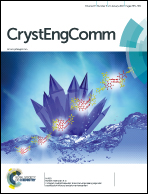Towards understanding intermolecular interactions in hydantoin derivatives: the case of cycloalkane-5-spirohydantoins tethered with a halogenated benzyl moiety†
Abstract
A series of cycloalkane-5-spirohydantoins bearing a halogeno substituted benzyl group (X = Cl and Br) in position 3 has been synthesized and their structures (1–6) have been determined by a single crystal X-ray diffraction method. These compounds have multiple functional groups, which allow greater competition and/or cooperation among the different intermolecular interactions in the formation of their crystal structures. The molecules are linked together by paired N–H⋯O hydrogen bonds in R22(8) rings, while the C–H⋯O interactions lead to their further association into double chains. The contribution of the cycloalkyl ring depends on its conformational flexibility and the multiple C–H donor implications. In the case of compounds 1–4 bearing the cyclopentyl or the cyclohexyl ring, halogen bonding (X⋯O) interactions give rise to a supramolecular pseudo-hexagonal network. In addition, the C–H⋯X interactions with a higher degree of multifurcation at the halogen acceptor have an important role in the formation of the crystal structure. Regarding compounds 5 and 6 with the cycloheptane ring, the X⋯O interaction is absent, and along with the C–H⋯X interactions, these compounds realize an alternative crystal structure with an emphasis on the X⋯π interactions. The lattice energies of all these crystal structures, as well as the intermolecular pair energies, have been calculated using PIXEL and further partitioned into coulombic, dispersive, polarization and repulsive factors. The crystal structures have also been subjected to Hirshfeld surface analysis which reveals that approximately 75% of the close contacts correspond to relatively weak interactions. The application of both concepts has provided a new insight into the relationship between the molecular interactions and crystal structures of the hydantoin derivatives.



 Please wait while we load your content...
Please wait while we load your content...